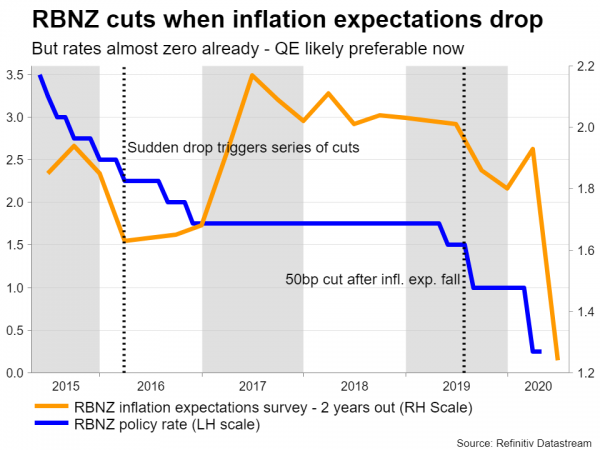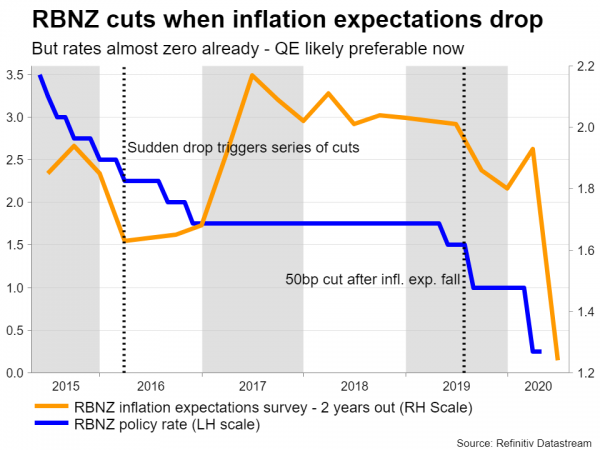The Reserve Bank of New Zealand will wrap up its policy meeting at 02:00 GMT Wednesday, and recent developments suggest that more stimulus is needed. A rate cut is probably off the cards for now, so the central bank is more likely to expand its QE program instead. As for the kiwi, its reaction may depend mainly on how open policymakers appear about cutting rates again in the future. In this sense, the risks surrounding the currency seem asymmetric and tilted to the upside, as a lot of gloom has been priced in already.
Not out of the woods yet
The pandemic has ravaged the world economy, and New Zealand was no exception. From the few post-lockdown data points that have been released so far, electronic card sales plunged by an eye-watering 47% in April, signalling that consumption fell off a cliff. Meanwhile, the RBNZ’s own survey of inflation expectations – which the central bank pays a lot of attention to – showed 2-year inflation expectations falling to the lowest level on record, foreshadowing a similar drop in actual inflation.
On the bright side though, the nation handled the health crisis itself very well. New cases of infection are extremely low, allowing the government to slowly re-open the economy with very low risk of second waves hitting. By extension that implies a very low probability of future shutdowns.

Still, things are unlikely to go back to normal anytime soon. Social distancing requirements will remain, forcing many businesses to operate at reduced capacity, the tourism industry will likely be decimated, exports may struggle given the global environment, and consumers may be more cautious overall amid widespread job losses. As such, the economy will likely require more stimulus, and both the government and the RBNZ are set to deliver this week.
More QE, but what about negative rates?
The RBNZ already cut rates to 0.25% back in March and launched its first Quantitative Easing (QE) program a few days later. Thus, its options now are relatively limited. It can either cut interest rates further, to zero or even negative, or expand the size of its QE program.
It will likely opt for the latter, at least for now. RBNZ Governor Adrian Orr recently indicated that he is open to using negative rates, but that policy tool is very controversial because it hurts the commercial banking sector and might therefore weaken the overall financial system. Plus, back in March, the central bank committed to keeping rates “at this level for at least 12 months”, so another rate cut now without changing that guidance first could damage its credibility.
What about the kiwi?
Quantitative Easing aims to push longer-term interest rates down. For the FX market though, what matters more are short-term interest rates. As such, the kiwi dollar might react much more to any signals about a future rate cut rather than the QE decision, which is widely expected already.Specifically, will policymakers change their guidance to indicate that rates will stay ‘at this level or lower for at least 12 months’? Markets seem to think that’s a realistic scenario, as they assign a 50% probability for a rate cut by August, which increases to 80% by November.
Given market pricing, the risks surrounding the kiwi’s reaction seem asymmetric. If the central bank does change its guidance and opens the door for lower rates, the currency might drop but only modestly, as much of that is priced in already. However, if the officials keep their wording on rates unchanged, that might call into question the entire narrative for more rate cuts, generating a significant upside reaction.

Looking at kiwi/dollar technically, an upside move could meet initial resistance near the 0.6175 region. If violated, the next target for the bulls may be the 0.6240 zone.
On the downside, support may be found around the 0.6000 handle, which roughly encompasses the 200-period simple moving average (SMA) at 0.6016. If penetrated, the focus would turn to the 0.5920 area.
Finally, note that the government will announce its new spending plans to support the economy at 02:00 GMT Thursday, one day after the RBNZ decision. The size of that fiscal stimulus package could also impact the kiwi – the bigger the better.


 Signal2forex.com - Best Forex robots and signals
Signal2forex.com - Best Forex robots and signals




